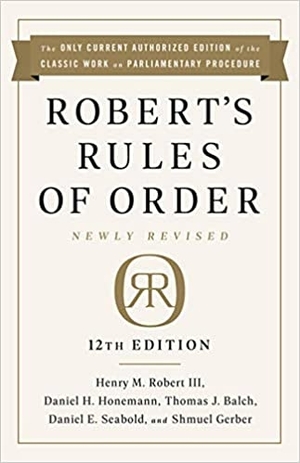The importance of Special Rules and Standing Rules for healthy organizations

Brigadier General Henry Martyn Robert was a genius. After a disastrous 14-hour meeting in 1863, he reflected for 13 years and attended lots of meetings. From those experiences as well as research into British parliamentary law and rules of the U.S. House of Representatives, he created what has become the most widely used manual of parliamentary procedure in the United States, Robert’s Rules of Order Newly Revised. This flexible document can benefit local government and non-profit organizations. Its flexibility is not generally recognized.
This article focuses on two different types of rules: Special Rules and Standing Rules. Ask most people who participate in meetings that ostensibly use Robert’s Rules of Order, and you’re likely to get blank stares when this subject comes up. The absence of this knowledge ripples into organizations and major problems result.
Special Rules
By taking advantage of Special Rules, you can customize key elements of Robert’s Rules of Order to meet your needs.
To be clear, Special Rules are rules that supersede Robert’s Rules of Order. Adoption or amendment of Special Rules requires a Main Motion, and either (a) previous notice and a two-thirds vote or (b) a vote of a majority of the entire membership.
Here is an example of the use of a Special Rule: Robert’s Rules of Order says each speaker may speak two times for up to 10 minutes. It also says you can create a Special Rule and modify the time, the number of opportunities or both that someone can speak. See this link for an example.
Organizations should consider using this and other diversions from Robert’s Rules of Order that work for them—subject to the constraints of state law, of course.
Do not treat the tool, Special Rules, as optional. When you are establishing your organization (a time when debate over the bylaws can become intense and when many people may want to speak), you can use a Main Motion to create a Special Rule.
Unlike amending bylaws, amending Special Rules does not require a vote of the entire membership. This key distinction makes changing Special Rules easier. Robert’s Rules of Order says they should be placed under a separate heading in a notebook that also holds your bylaws. Special Rules provide flexibility and as such are a very tasty icing on an already delicious cake.
If anyone who attends meetings is not apprised of the existence of either Standing Rules or Special Rules, they are not likely to understand the procedures of the organization. Confusion, misunderstandings, disillusionment, and anger can set in. There are many problems in organizations. For example, many fall short in getting new members to read and understand their bylaws. Equally important is their failure to educate members about Special Rules and Standing Rules. These documents all play a significant role in guiding the day-to-day operations of the organization.
Standing Rules
Standing Rules are different from Special Rules. They are housekeeping rules.
Standing Rules should be placed in another section of that notebook. They may not be as powerful as Special Rules, but they may come into play more frequently.
Standing Rules are related to the administration of a society rather than to parliamentary procedure. Some organizations fall into the trap of placing these housekeeping rules in their bylaws. The effect of doing so sets them in stone and defeats the purpose of this tool. Standing Rules can be established by majority vote without previous notice. They can, for example:
- establish a time and place for meetings,
- create a seating arrangement,
- determine what refreshments will be served, and,
- if the body meets remotely, create the rules that are advised for this purpose in the twelfth edition of Robert’s Rules of Order.
By creating these standard housekeeping rules, you won’t have to adopt them at every meeting. Consequently, you’ll save time. These rules can be temporarily suspended by a majority vote, and after that occurrence, bounce back to the way they were. Changing aspects of a meeting is a perfect example of the use of a Standing Rule. If circumstances demand it, democratic change can occur. Failing to utilize this approach likely abdicates authority to the organization’s leader. That could be the beginning of a very slippery slope, and we hope you avoid it.
Amending bylaws calls for a higher threshold. That’s why it is unwise to put Standing Rules in your bylaws. Special Rules and Standing Rules are subordinate to the bylaws and cannot contravene or contradict them (or any laws or administrative codes that govern the organization).
Special Rules and, Standing Rules should be displayed prominently, especially if your meetings are open to non-members and include Public Comment. Because there is the option of creating these rules, Robert’s becomes the best tool both for meeting management and organizational development.
In conclusion
At the beginning of this article, we said General Robert was a genius. We think his wisdom in creating the nine elements of bylaws is an example of that (read Why Bylaws here). The creation of Special Rules and Standing Rules is further evidence. They allow you to make Robert’s Rules of Order as perfect as your organization can make them, and we are sure you will find them incredibly useful.

Ted Weisgal, member, National Association of Parliamentarians
Ted Weisgal, with the assistance of Dr. Martha Haun, PRP, wrote Robert’s Rules for Kids and Big Kids…A Guide to Teaching Children of All Ages the Basics of Parliamentary Procedure. Special Rules and Standing Rules are addressed in it. The book is an effort to support the growth of Robert’s Rules, reinforcing the nearly identical words in the governing documents of the National Association of Parliamentarians and the American Institute of Parliamentarians: “This subject should be taught to all students in all grades in all schools, public and private.” Learn more about Robert’s Rules for Kids here.


Great article! It shows that Robert’s Rules is not a written in stone type of meeting procedure. There is flexibility for groups to make rules that make sense for them, within the RONR framework, and help them to get things done as an organization.
Thanks Dave! Appreciate your writing. Best, Ann